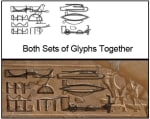Helicopters in Ancient Egypt?
Helicopters in Ancient Egypt?
Perhaps the most famous image from the archaeology of ancient Egypt that is offered in support of ancient alien visitation and influence is the so-called “Abydos helicopter.” The name comes from a set of hieroglyphs found above a doorway within the Temple of Seti I in Abydos. The glyphs appear to show modern machines—a helicopter, a jet planet, and perhaps spaceship (Figure 1):
 Figure 1
Figure 1

The image is well-known to Egyptologists, who reject the notion that it depicts these modern craft. The reason for the rejection is not disdain for ancient alien theory (though they would consider that idea ridiculous). Rather, the reasons are that Egyptologists know how to read hieroglyphs, know the hieroglyphs associated with Seti I and his reign, and know how this particular set of glyphs was formed. Understanding all those items is essential to understanding what we are looking at.
Helicopters in Ancient Egypt?
The MDW-NTR website, devoted to the online study of hieroglyphs, has an excellent, lengthy explanation of what the glyphs on this door lintel are. The relevant essay begins:
The glyphs are a result of both erosion of the stone surface (evident elsewhere in the temple) and the process of filling in and re-carving the stone to replace some of the original hieroglyphics. The technical term for such a surface that has been written on more than once is called a palimpsest. The usurping and modifying of inscriptions was common in ancient Egypt throughout its history. The glyphs here were modified at least once in antiquity, and perhaps twice. Some of the filling has fallen out in places where the older and the newer inscriptions overlap, and the result is unique and odd-looking. . . . Seti's son Rameses II hastily completed and decorated several sections of the temple and in some instances Rameses II placed decorations over those of his father. The picture that is believed to be of space and air craft is one such re-decoration or palimpsest. The text is part of the titulary ("title") of Ramesses II which replaced the royal titulary of Seti I that was originally carved into the stone.
There are some items in this statement that are crucial for us to understand. Egyptologists know the following with absolute certainty:
- When Seti I lived and died
- Who replaced Seti I as pharaoh (Ramesses II – “the Great”)
- Ramesses II had to finish Seti’s tomb. (Ramesses’ own records provide this information).
- That hieroglyphs in certain sections of the tomb (the “helicopter” inscription being one such instance) were carved over when Ramesses II replaced the titular of Seti I with his own titular. (Remember, this is a temple, not a tomb).
- The hieroglyphs that were part of the titularies (lists of names) of both Seti I and Ramesses II are well known since they are preserved in multiple records.
- The hieroglyphs that represent the “helicopter” and “spaceship” occur in no other hieroglyphic inscription.
The reason these glyphs are unique is because they are not actual hieroglyphic characters. They are what resulted from the over-carving. The MDW-NTR site explains the process of this over-carving step-by-step and glyph-by-glyph. We offer only a summary of their work here.
During the reign of Seti I, part of Seti’s titulary (his list of names) read as follows (Figures 2 and 3):
 Figure 2: The translation (reading left to right) is: "the nine bows" "to drive out"
Figure 2: The translation (reading left to right) is: "the nine bows" "to drive out"
 Figure 3 Example from a stela of Seti I found at the Sinn el Kaddab, in the region of Kurkur Oasis (Darnell). This stela preserves the fivefold titular of Set I (i.e., all five of his names).
Figure 3 Example from a stela of Seti I found at the Sinn el Kaddab, in the region of Kurkur Oasis (Darnell). This stela preserves the fivefold titular of Set I (i.e., all five of his names).
Here is part of the titulary of Ramesses II, who succeeded his father Seti I as pharaoh (Figure 4):
 Figure 4 The translation (reading from left to right) says: "to conquer, subdue" "to protect KMT (Egypt)"
Figure 4 The translation (reading from left to right) says: "to conquer, subdue" "to protect KMT (Egypt)"
Here’s what happens (see Figure 5) when the glyphs from Ramesses’ name are carved over the glyphs from Seti’s name—look familiar?
 Figure 5
Figure 5
The over-carving of Ramesses’ glyphs to replace his late father, Seti I, in this temple provides a complete, coherent explanation of how these utterly unique glyphs were created. In combination, they are meaningless.That is, the “helicopter” and “spaceship” hieroglyph have no translation value, because they are palimpsest creations. They were not hieroglyphs used in the Egyptian language.
Consequently, the hieroglyphs from the tomb of Seti I are not proof of advanced aircraft (alien or otherwise).
Resources
“Aliens And Space Crafts in Ancient Egyptian Temple – Explained,” MDW-NTR website (July 2013)
Peter James Brand, The Monuments of Seti I: Epigraphic, Historical, and Art Historical Analysis (Brill, 2000)
Ronald J. Leprohon The Great Name: Ancient Egyptian Royal Titulary (Society of Biblical Literature, 2013)
John Coleman Darnell, "A Stela of Seti I from the Region of Kurkur Oasis," Ramesside Studies in Honour of K. A. Kitchen (edited by Mark Collier and Steven Snape; Rutherford Press, 2011), 127-144
What is your response?


